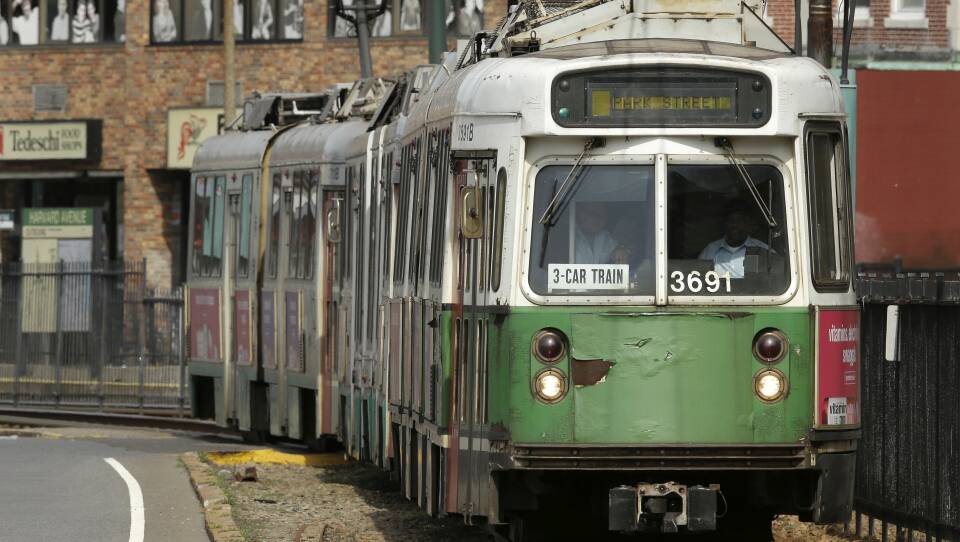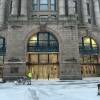It’s Monday in Greater Boston. That means it’s time to spill the T. This week’s question: What are your favorite and least favorite lines?
Morning Edition co-hosts Paris Alston and Jeremy Siegel got to the bottom of it. Plus, they asked the MBTA’s chief engineer: why does the Green Line make that sound?
Paris Alston: Jeremy, what time is it?
Jeremy Siegel: Paris, come on. You already know it's time to Spill the T.
[Segment intro music]
Siegel: I wish I had a nice cup of tea. From the newsroom, I'm Jeremy Siegel.
Alston: And I'm Paris Alston. You can have some of my tea, Jeremy. This is Spill the T, where each week we dish about the T — the MBTA, that is.
Siegel: This week's topic, the best of trains and the worst of trains. We ask you what your favorite T line is — and what your least favorite is. You had a lot to say, both on Twitter and by email.
Alston: That's right, we heard from Karen Shepherd, who says her favorite is the Red Line — mine too, Karen. But she avoids the Orange Line, which I feel like is kind of messed up because the Orange Line is really vast and broad — and orange.
Siegel: I’ve taken it a lot recently.
Alston: Yeah, yeah. But you know, the Red Line is a favorite among listeners, Jeremy. Bettina Norton's favorite is also the Red Line, and she got very specific with why. She loves that it crosses the Longfellow Bridge and overlooks the Charles, Back Bay and Beacon Hill. And Bettina even has a favorite destination: the former final stop. You know, I can just see myself sitting on the Red Line right now, Jeremy, going across the Charles.
Siegel: Yeah, I posted on Twitter actually recently about what's the best view in Boston, and a lot of people said that that is the best view! From the train.
Alston: I'd have to agree with them. We also had a comment from Jane Taylor, who loves the trolley from Ashmont to Mattapan. Jane says for many local families, it was a regular go-to as a treat for young children. Jane says, “It was our amusement park midday.” Oh my goodness, like that sounds exhilarating. Jane even shared that her family got to know the conductor of that trolley, such that the conductor let her daughter sit in the driver's seat. And it is also the only line that goes through a cemetery, which could be a really interesting attraction for tourists who love trains.
Siegel: That's a fun fact.
Alston: So, Jeremy, the Green Line seemed to have been the least favorite thing. And, you know, we all have a little bit of a love hate relationship with the Green Line, right?
Siegel: Yeah, I had one person write to me on Twitter saying that they love it because it makes them nostalgic for old streetcars. So there is some love.
Alston: Yeah, there is some love, you know? But there also still is a lot of hate. And one reason people cited that they hate the Green Line was this.
[loud metallic screeching sound]
Alston: Ooh, ooh, my ears!
Siegel: It’s like a horror movie! Yeah. So that's the screeching that we all know and do not love. But Paris, I looked into why there is that squeaking, why there's so much screeching and why there's so much noise. And to find out, I called up the MBTA’s chief engineer.
Eric Stoothoff: So my first name is Eric, my last name is Stoofhoff, and I'm the chief engineer for the MBTA.
Siegel: Now, Eric told me that the screeching happens when trains are going around a curve — where you have steel from the wheels rubbing against more steel from the tracks. And the Green Line in particular has a lot of these sharp turns.
Stoothoff: So the trains themselves, they have trucks, generally four wheel sets. And so there's there's a geometry to those. And as those navigate the curves, they put pressures on the rails. And in some cases, in really tight curves, we have what's called restraining rail, where we will have the running rails that the travel surface of the wheels will ride upon but then you'll have, inboard of those rails, you'll have restraining rails that the backside of the wheels will sometimes rub up against as part of the geometry and the way that the infrastructure works with the vehicles.
Siegel: To translate, in addition to the normal rail that the train goes on, where there are sharp bends like on the Green Line around, say, Boylston Street, there are extra guardrails that cause even more noise. But they help keep your ride smooth. So in effect, even though you hate the noise, the noise you're hearing basically means that the train is helping keep you safe and help keep your ride smooth. So it sounds bad, but it might feel better.
"It's like a horror movie! Yeah. So that's the screeching that we all know and do not love."Jeremy Siegel, on the Green Line’s infamous screech
Alston: OK, so I’ll remember that the next time it's like ringing in my ears minutes after I get off the Green Line. And so I'm curious, can they fix this, though?
Siegel: They kind of have to work with what they're given. The T system was built more than a century ago. But Eric told me a bit about things they're doing now, like oiling the tracks and the tires. And there are some long term fixes that they're looking into.
Stoothoff: I think as we go forward with some of the planning for the future of the Green Line and how we will think about the future — Boylston Station — will be able to take a little bit of that screeching noise out because we'll be able to change the geometry a little bit.
Siegel: But there's a catch it'll take at least till the end of this decade or the beginning of the next decade to figure something else like that out.
Alston: All right. Well, next week's question is a juicy one. What is the wildest or weirdest thing you've seen on the T? Hit us up on Twitter by tweeting @GBHNews using the hashtag, #ParisandJeremy. You're listening to Morning Edition on GBH.









